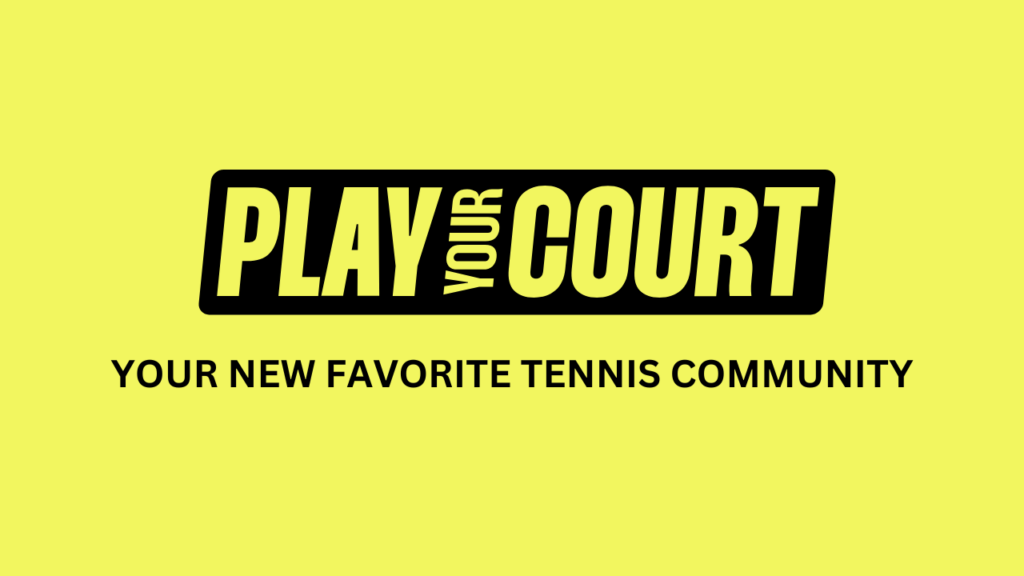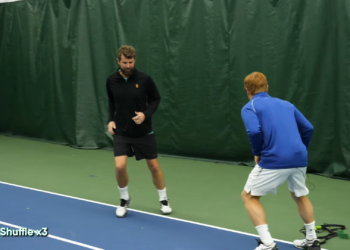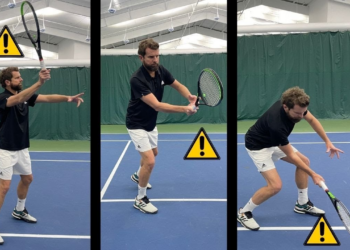“Can I switch hands in the middle of a point?”
Yes… but it’s not quite that simple.
Whether you’re recovering from an injury, experimenting with a two-forehand game, or just curious if it’s a viable strategy to level up, switching hands in tennis is one of those weird-but-fascinating topics that deserves a deep dive.
And most coaches will tell you not to bother. But if you know anything about PlayYourCourt, you know we’re not “most coaches.”
I built this company to make tennis more accessible, more fun, and more tailored to your journey, not some outdated idea of what “serious” tennis should look like.
So if you’re toying with the idea of playing ambidextrously, or you’ve been forced to switch due to injury, or you’re just here out of pure curiosity, you’re in the right place.
If you’re looking for any edge to shake things up or you’ve got a cranky elbow that just won’t quit, switching hands could be more than just a gimmick. It could be your next big leap forward.
Is It Legal to Switch Hands in Tennis?
Absolutely.
According to the ITF rules of tennis, there’s no restriction whatsoever on which hand you use to hold the racquet or how often you can switch between them.
You can change hands mid-rally, between points, during a serve, or even every other shot if you’ve got the coordination. There’s nothing in the rulebook that says you can’t play ambidextrously.
But just because it’s legal doesn’t mean it’s common, especially at the pro level.
You might be surprised to learn that Michael Chang, a former top-10 ATP player, was known to switch hands mid-point in scramble situations.
And Rafael Nadal, who’s naturally right-handed, famously plays tennis left-handed, thanks to his early training.
Then there’s Yevgeniya Kulikovskaya, who competed on the WTA Tour and hit forehands off both wings, a rare but fascinating approach.
Still, these examples are exceptions, not the rule.
At the highest levels of the sport, the speed, precision, and muscle memory required make hand switching more of a novelty than a norm.
But at the recreational level? That’s a different story and one where switching hands might make a lot more sense.
Why Would a Player Want to Switch Hands?
Switching hands in tennis isn’t something most players wake up and randomly decide to do. But sometimes it’s a solution.
To Avoid or Recover from Injury
One of the biggest reasons players make the switch is injury.
Chronic tennis elbow, rotator cuff issues, or nagging wrist pain can sideline your dominant arm for weeks or permanently. I’ve coached players who were ready to quit until they realized: What if I just played lefty instead?
And here’s the crazy part, it works.
Some players who switched due to injury not only stayed on the court but climbed their way back to 80–90% of their original skill level within a year or two.
That doesn’t happen by accident, it takes deliberate practice, but it’s absolutely doable.
To Gain Tactical Flexibility
There’s also the strategic side.
Playing ambidextrously allows you to hit forehands off both wings, creating wider angles, attacking short balls more aggressively, and avoiding that vulnerable moment when a weak backhand gets picked on.
Imagine reaching for a wide ball on your backhand side and just flipping the racquet to your other hand to hit a forehand winner instead.
That’s deadly, especially at the rec level where players aren’t expecting it.
To Bypass a Weak Backhand Altogether
Most club-level players have a backhand that’s “survive, not thrive.”
If your backhand is the weakest link in your game, switching hands might allow you to skip it entirely. That doesn’t mean it’s easy, but for some, it’s worth the grind.
I’ve worked with players who couldn’t keep their two-hander in the court to save their life.
But after a few months of off-hand training, they were cracking clean, confident forehands on both sides of the court. They actually enjoyed learning again.
Whether you’re coming back from injury or just looking for a tactical edge, switching hands can be a lifeline.
The Benefits and Drawbacks of Switching Hands in Tennis
Like any bold tennis experiment, switching hands comes with its own set of trade-offs.
Some players unlock a whole new gear. Others get frustrated and bail before the serve toss even makes sense.
Here’s what to expect on both sides of the net.
Pros
Full-Court Forehand Coverage
Forehands on both wings? That’s a strategic upgrade.
By switching hands instead of relying on a backhand, you gain access to wider angles, heavier topspin, and more aggressive court positioning. You basically remove one of the biggest liabilities in amateur tennis.
Surprise Factor for Opponents
At the club level, most players expect traditional patterns, forehand, backhand, repeat.
But a sudden switch mid-point? That can completely throw off your opponent’s rhythm.
It’s a psychological edge, and can be the difference-maker.
Reduced Overuse Injuries (If Done Right)
If your dominant arm is breaking down, giving it a rest while training your non-dominant side can extend your playing life.
Many players come back stronger and more balanced physically after incorporating their off-hand. Think of it like giving your body a reset, without quitting the sport you love.
Cons
Slower Transitions Mid-Rally
Switching hands isn’t always seamless. If your timing is even a half-second off, you’ll miss the shot or worse, get stuck in no-man’s land mid-grip change.
Reaction time matters, and the faster the ball, the tougher the switch.
Weak Off-Hand Serve
Let’s not sugarcoat it: the serve is the hardest shot to relearn with your other hand.
Many players who switch hands end up using an underhand serve for weeks or months until their toss and motion sync up again.
That can make league play or competitive matches a challenge early on.
Time-Consuming to Relearn Core Mechanics
You’re not just flipping your racquet, you’re rebuilding an entire skill set.
From footwork to timing to follow-through, it can feel like starting from scratch. And yes, a lot of players wonder: “What if I end up worse on both sides?” It’s a valid concern.
Without structured training, it’s easy to plateau or give up too early.
Bottom line: switching hands can unlock powerful advantages, but it’s not a shortcut.
You’ve got to love the process, embrace the awkwardness, and have the patience to push through the growing pains. If you do? The payoff can be huge.
Real-World Stories: What Players Say About Switching Hands
I’ve coached a lot of tennis players through transitions, changing grips, revamping their serve, rebuilding a broken forehand.
But one of the most inspiring transformations I’ve seen? Players who completely switch hands and climb their way back to form.
Here are a few stories I’ll never forget:
“My non-dominant forehand is now stronger than my original one.”
This one blew me away. A former two-hander found so much power and spin in his lefty forehand that it actually outpaced his original dominant-side stroke.
It took a year of drills, video feedback, and reps on the ball machine, but now he hits cleaner and more confidently on both sides.
“I’m hybrid, serve righty, rally lefty.”
Who says you have to commit 100%? Some players develop a hybrid style, using their dominant hand for serving (where coordination is most demanding), and their off-hand for groundstrokes and returns.
It’s not traditional, but for recreational players, it’s highly effective and surprisingly adaptable.
“Fetching balls with my left hand helped me develop a lefty serve.”
This tip is gold. One player mentioned he played catch with his dog using only his non-dominant hand.
Over time, this small daily habit helped him build the coordination to develop a proper lefty serve. Unconventional? Sure. But sometimes, that’s exactly what works.
🧠 Pro Tip: Build Neural Coordination Daily
If you’re serious about learning to play off-handed, don’t limit yourself to the court.
Try brushing your teeth, opening doors, or even writing with your non-dominant hand.
Daily repetition rewires your brain, and over time, those gains translate directly to your swing.
Do Any Pro Tennis Players Switch Hands?
Yes, but let’s manage expectations.
While switching hands is 100% legal, very few professional players actually do it, and even fewer do it consistently at a high level.
The demands of the pro tour, speed, timing, and consistency, make ambidextrous play more of an outlier than a trend.
🎾 Michael Chang
Occasionally switched hands mid-rally to flick forehands when stretched wide.
🎾 Nicolas Rosenzweig
Played with a two-handled racquet and used double forehands; peaked around ATP #700.
🎾 Yevgeniya Kulikovskaya
WTA Top 100 who hit forehands on both wings instead of using a backhand.
But don’t get too excited, these are exceptions.
Most pros stick to one dominant hand, especially for serves, where timing and consistency are critical. Switching hands is more practical, and fun, at the rec level.
How to Train Your Non-Dominant Hand
If you’re serious about switching hands, here’s the truth: it’s going to feel awkward at first.
That’s normal. Think of it like learning to write with your other hand, slow, shaky, but completely possible with practice. Here’s how to speed up the process.
Step-by-Step Transition Plan
Ball Machine Drills
Repetition is key. A ball machine gives you a consistent feed so you can groove your stroke without pressure or judgment.
Video Feedback
Film yourself or use PlayYourCourt’s video analysis tools to compare your form and track progress. Seeing what’s actually happening makes a big difference.
Mirror Training
Stand in front of a mirror and mimic your dominant side’s motion with your non-dominant hand. Visualization reinforces motor learning.
Non-Tennis Activities
Use your off-hand for everyday tasks, brushing teeth, throwing a ball, even stirring your coffee. These habits build coordination faster than you’d think.
Recommended Tools & Resources
PlayYourCourt Coaching
Our coach-matching system can pair you with someone who’s trained players through this exact journey, so you don’t have to figure it out alone.
Video Tips Library
We call them “magic pills” for a reason, quick, effective fixes for specific struggles that’ll accelerate your learning curve.
Serve Challenge
Try one of our guided challenges, like the Serve Challenge, with your non-dominant hand. It’s a fun, focused way to build one of the hardest skills in tennis, without burning out.
Switching hands is about training your brain to move differently.
With the right tools, structure, and support, it’s exciting.

Want to Try Switching Hands?
If you’ve made it this far, you’re someone who’s curious. Determined.
Maybe you’re recovering from an injury, or maybe you’re just stuck in that frustrating plateau where nothing seems to click.
Either way, the fact that you’re exploring something as unconventional as switching hands tells me one thing, you’re serious about improving.
Whether you’re rebuilding your game from the ground up or testing new strategies to outsmart your Saturday league rival, we’ve built a platform that meets you where you are.
You’ll get access to:
- 🎾 Personalized coaching from instructors who understand your unique goals
- 📺 On-demand video tips and game-changing challenges designed for real-world improvement
- 👫 Partner-matching tools to keep you practicing, not just thinking
- 🛠️ Progress tracking and support to help you stay motivated and engaged
We’re not country club tennis. We’re the game-improvement platform for the real tennis player, the one who’s ready to experiment, adapt, and level up faster.
👉 Try 7 days of coaching free and get paired with a coach who actually gets your journey.
Let’s flip the script, and maybe even the racquet.



